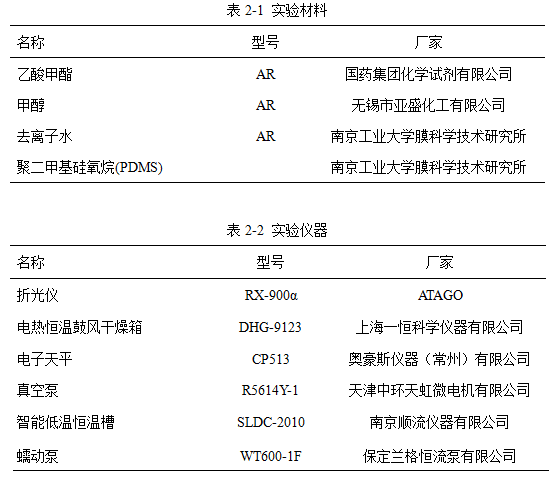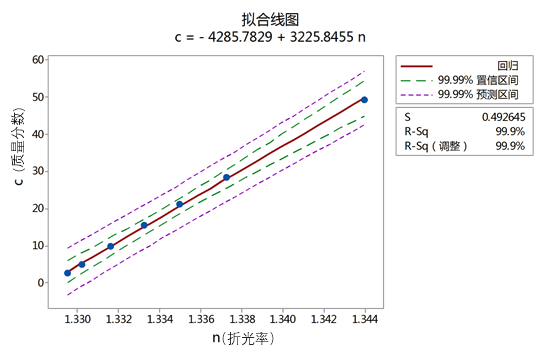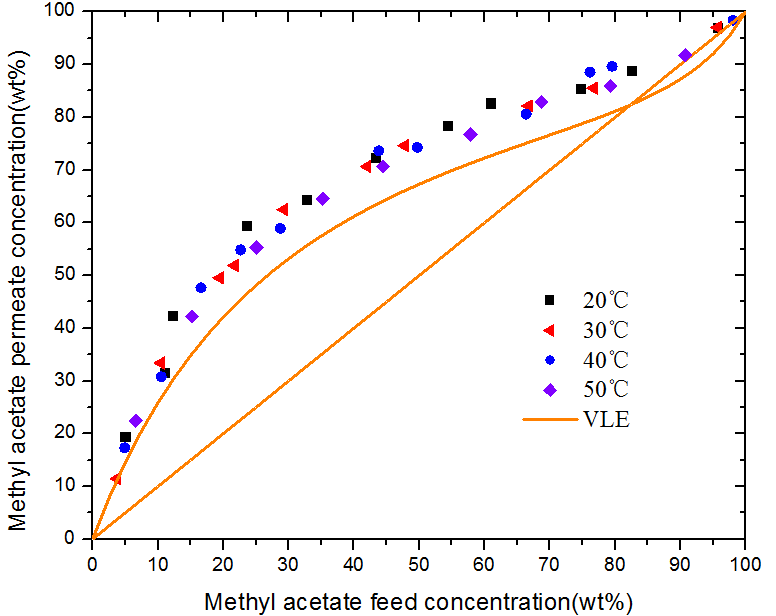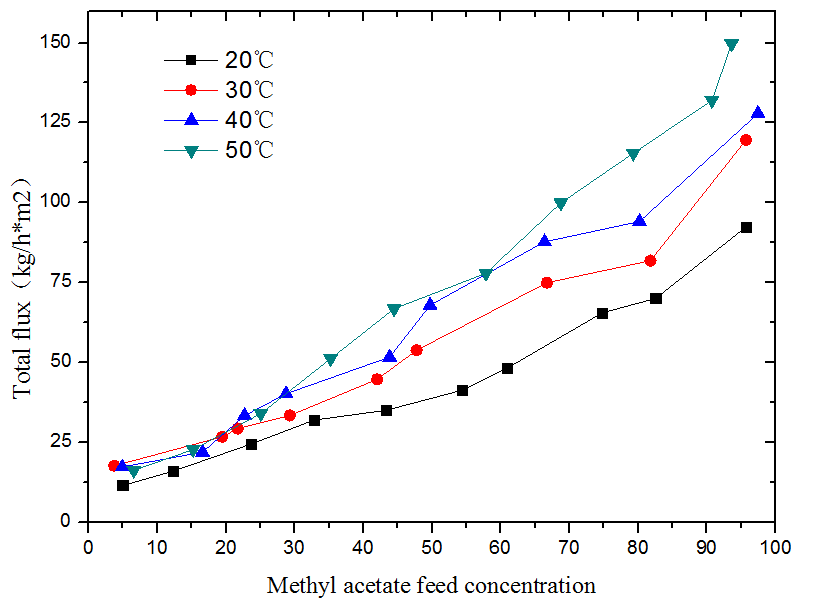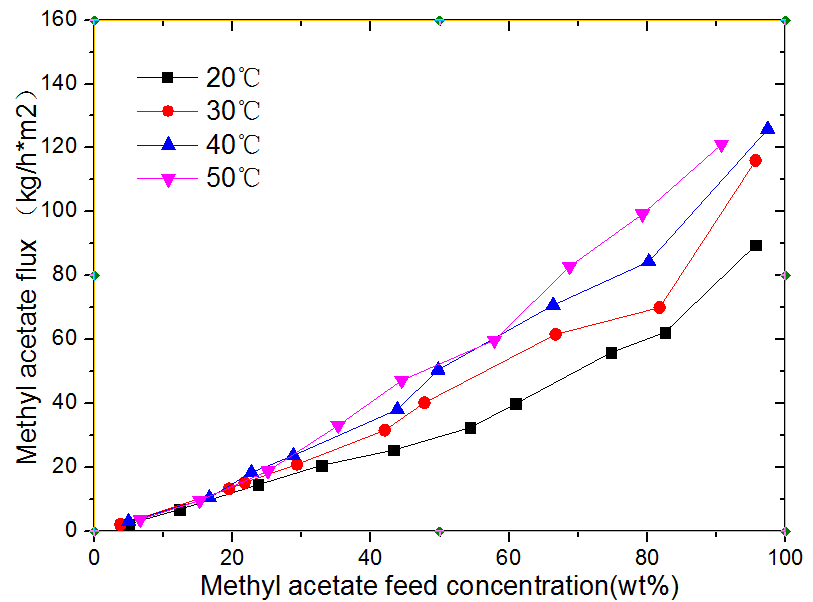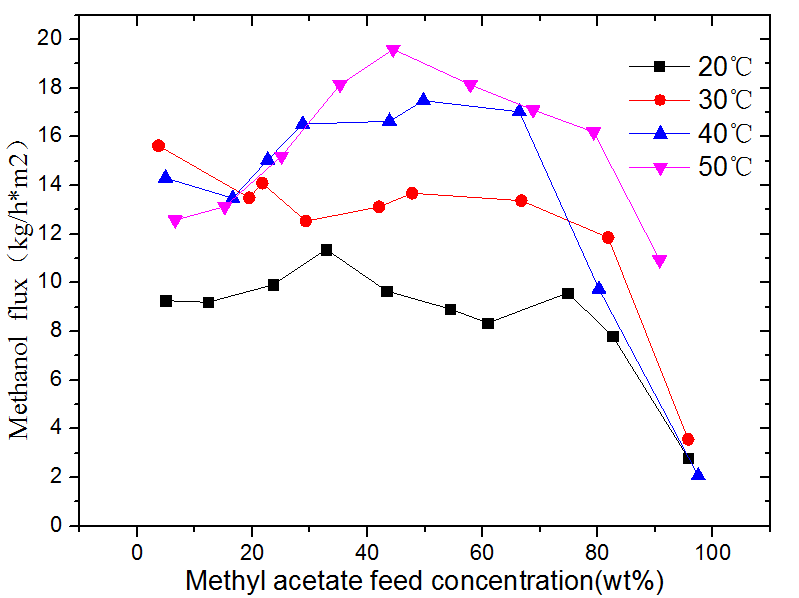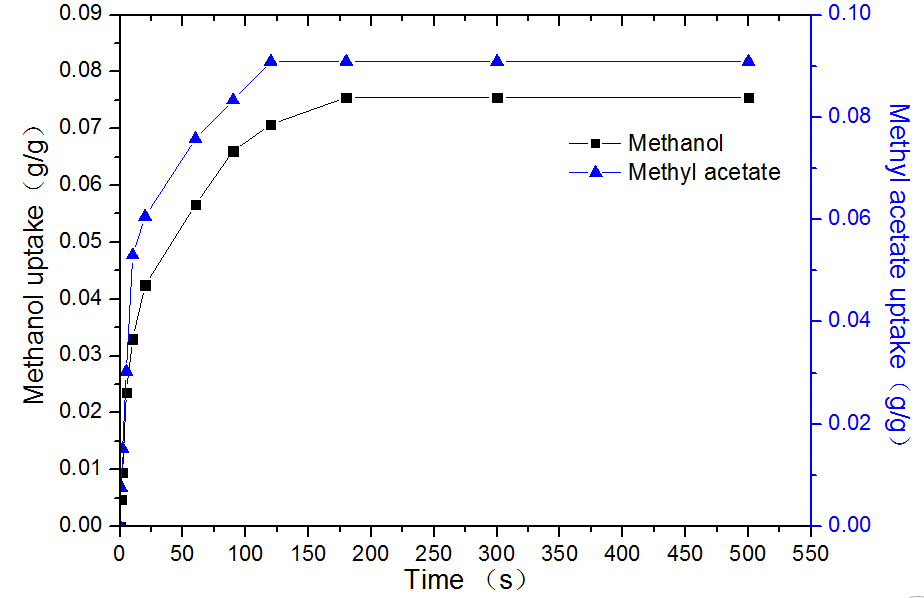乙酸甲酯甲醇共沸体系渗透汽化分离研究毕业论文
2020-06-17 21:43:47
摘 要
在工业生产乙酸甲酯的过程中,由于甲醇的过量导致产物中出现乙酸甲酯和甲醇的混合物,而如今乙酸甲酯已经成为一种用途广泛的工业产品,这使得乙酸甲酯/甲醇体系的分离研究具有重要意义。本课题将采用渗透汽化分离技术,利用分离膜对乙酸甲酯和甲醇溶解扩散选择性的不同实现两者的有效分离。
课题采用聚二甲基硅氧烷/聚四氟乙烯复合膜为研究对象,探究了实验的操作温度、进料侧乙酸甲酯的浓度以及进料流量对乙酸甲酯/甲醇体系分离的渗透通量以及选择性的影响。实验结果表明,该膜对乙酸甲酯/甲醇体系具有良好的分离性能,能够突破精馏边界。其中渗透通量会随着实验温度,原料液乙酸甲酯浓度或膜面流量的增大而增大。此外,进料液乙酸甲酯的浓度的增加会使得选择性降低,但是进料液体的体积流量和实验温度对分离的选择性并没有明显影响。一方面是由于在PDMS膜面上乙酸甲酯比甲醇能够更快达到吸附平衡,并且吸附量更大;另一方面,根据Flory-Huggins方程可知乙酸甲酯对PDMS的亲和性比甲醇更强,所以乙酸甲酯更容易在PDMS膜中进行溶解扩散。最后对膜进行了长期稳定性的测试,测试结果显示在两周的时间内通量和分离因子都较稳定,说明分离膜稳定性较好,具有较强的应用前景。
关键词:渗透汽化 ; PDMS膜 ; 乙酸甲酯/甲醇体系 ; 膜分离
Study on the pervaporative separation of methyl acetate/methanol azeotropic mixture
Abstract
In the production of methyl acetate, methanol in the reactants is excessive, so the reaction product contains methyl acetate/methanol azeotropic mixture. And now methyl acetate has become a widely used product, so the separation of methyl acetate / methanol azeotropes is important. This studu used the pervaporation technology and the different selectivity of the separation membrane on the methyl acetate and methanol to achieve the effective separation of the mixture.
Polydimethylsiloxane / polytetrafluoroethylene composite membrane was used in this study. The influences of the experimental temperature, the methyl acetate concentration and the feed flow on the total flux and selectivity of the methyl acetate / methanol mixture were tested. The experimental results showed that the membrane has good separation performance to methyl acetate /methanol mixture and can break through the boundary of rectification. When the experimental temperature, feed concentration, or feed flow increases,the permeation flux increases, too. In addition, an increase in the concentration of methyl acetate in the feed solution would result in a decrease in selectivity, but the volumetric flow rate of the feed liquid and the experimental temperature did not significantly affect the selectivity of the separation. On the one hand, methyl acetate can achieve faster adsorption equilibrium than methanol on the PDMS membrane, and capacity is greater; On the other hand, according to the Flory-Huggins equation, it was found that the affinity of methyl acetate to PDMS was stronger than that of methanol, it is easier for methyl acetate to dissolve and diffuse in the PDMS membrane. Finally, the membrane was tested for long-term stability. The results showed that the flux and separation factors were stable in two weeks time, and it could be considered stable and effective.
Key words:Pervaporation ;PDMS membrane ;Methyl acetate methanol azeotropes.
目 录
摘 要 I
Abstract II
第一章 文献综述 1
1.1 前言 1
1.2 膜分离技术简介 1
1.3 渗透汽化 1
1.3.1 渗透汽化基本特点 2
1.3.2 渗透汽化传质机理 2
1.4 PDMS膜在渗透汽化中的应用 4
1.4.1 分离有机物和水 4
1.4.2 水中脱除有机物 5
1.4.3 分离有机/有机体系 5
1.5 该实验课题背景及目的 5
第二章 实验部分 7
2.1 实验材料和仪器 7
2.2 实验分离性能的评定 7
2.3 实验器材和研究分析手段 8
第三章 结果与讨论 10
3.1 温度对分离效果的影响 10
3.3 液体体积流量对渗透汽化的影响 14
第四章 结论与展望 17
参考文献 18
致 谢 20
第一章 文献综述
前言
近年来,随着膜分离技术的迅猛发展,其在工业上的应用领域也在持续开发。其中对于有机混合物共沸体系分离的研究更是这项技术的重点和难点[1]。在工业中利用乙酸和甲醇制取乙酸甲酯的过程中,由于甲醇的过量会使得产物为乙酸甲酯/甲醇的混合体系,而且如今乙酸甲酯已经成为一个十分成熟、用途广泛的产品,这使得该共沸体系的渗透汽化分离研究变得尤为重要[2]。
甲醇是一个结构简单的有机物,是各种有机工业品的基本原料之一。另一个成分乙酸甲酯,如今的它已经逐渐成为一个十分成熟的的产品,它能够替代乙酸乙酯等等多种有机物的使用。同时该物质作为环境友好无污染的溶剂,它的主要作用还有各种有机物的生产,如树脂油墨,皮革产品以及各种有机溶剂。所以对于通过分离技术来获得纯净的乙酸甲酯与甲醇也是科学家们不断探索的课题。由于该共沸的存在,精馏这种传统的分离手段会受到热力学平衡的限制,即在气液平衡时,气液相组成相同,无法使其分离。但是渗透汽化不会受到热力学平衡限制,因此很利于实现一些精馏,萃取等传统的分离方法无法实现的分离任务。
1.2 膜分离技术简介
近些年来膜分离技术是一种十分热门的分离技术。该技术在20世纪初期就已经出现,1960年之后得到了迅速的发展。和精馏等其他的分离技术不同,膜分离技术在常温下就能够正常进行,该过程属于物理过程,并且可以在分子级别进行,因此具有卓越的性能。同时,膜分离技术的过程以及操作都较为简单,这就使得膜分离具有很强的适应性。能耗低也是膜分离技术的一大特点,可以作为一种更优化的技术来替代一些传统的分离技术。膜分离技术具有非常大的潜力,所以在之前的十几年时间内这项技术得到了前所未有的飞速发展。
1.3 渗透汽化
渗透汽化技术是膜分离中的一种,具有很多其他技术无法比拟的优势,特别是对于一些共沸体系的分离,相比于萃取精馏和共沸精馏这种传统的分离技术,该技术可节能1/3-1/2,而且能够节约的至少一半运营成本。
而对于这项术的机理以及过程有许多说法:其中对于其机理描述最清晰准确的原理或者模型当属溶解扩散原理。这种原理指的是通过进料液中各个物质在分离膜中扩散的速率的不同,其中速度快的成分通过膜与其他物质分离开来,到达膜的下游侧成为渗透液。
相关图片展示:
